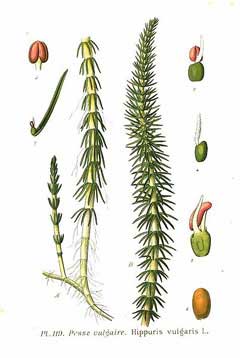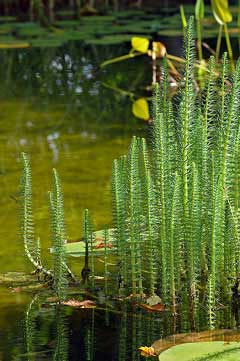 |
|
http://commons.wikimedia.org/wiki/File:119_Hippuris_vulgaris_L.jpg |
 |
| http://commons.wikimedia.org/wiki/User:Aka |
Translate this page:
Summary
Physical Characteristics

 Hippuris vulgaris is a PERENNIAL growing to 0.5 m (1ft 8in). It is in flower from June to July. The species is hermaphrodite (has both male and female organs) and is pollinated by Wind.
Hippuris vulgaris is a PERENNIAL growing to 0.5 m (1ft 8in). It is in flower from June to July. The species is hermaphrodite (has both male and female organs) and is pollinated by Wind.
Suitable for: light (sandy), medium (loamy) and heavy (clay) soils. Suitable pH: mildly acid, neutral and basic (mildly alkaline) soils. It cannot grow in the shade. It prefers wet soil and can grow in water.
UK Hardiness Map
US Hardiness Map
Synonyms
H. tetraphylla.
Plant Habitats
Pond; Bog Garden;
Edible Uses
Edible Parts: Leaves Shoots
Edible Uses:
Leaves and young shoots - raw or cooked[46, 61, 85, 257]. Used to make soups[257]. They are best harvested from autumn to spring, even the brown overwintered stems in spring can be used[172].
References More on Edible Uses
Medicinal Uses
Plants For A Future can not take any responsibility for any adverse effects from the use of plants. Always seek advice from a professional before using a plant medicinally.
Vulnerary
The whole plant is an effective vulnerary, the juice being taken internally or applied externally[4, 172].
References More on Medicinal Uses
The Bookshop: Edible Plant Books
Our Latest books on Perennial Plants For Food Forests and Permaculture Gardens in paperback or digital formats.

Edible Tropical Plants
Food Forest Plants for Hotter Conditions: 250+ Plants For Tropical Food Forests & Permaculture Gardens.
More

Edible Temperate Plants
Plants for Your Food Forest: 500 Plants for Temperate Food Forests & Permaculture Gardens.
More

More Books
PFAF have eight books available in paperback and digital formats. Browse the shop for more information.
Shop Now
Other Uses
References More on Other Uses
Cultivation details
Requires a wet soil or shallow water, preferring one that is base-rich[17]. Dislikes shade. Plants have a spreading root system and can be very invasive[1].
References Carbon Farming Information and Carbon Sequestration Information
Temperature Converter
Type a value in the Celsius field to convert the value to Fahrenheit:
Fahrenheit:
The PFAF Bookshop
Plants For A Future have a number of books available in paperback and digital form. Book titles include Edible Plants, Edible Perennials, Edible Trees,Edible Shrubs, Woodland Gardening, and Temperate Food Forest Plants. Our new book is Food Forest Plants For Hotter Conditions (Tropical and Sub-Tropical).
Shop Now
Plant Propagation
Seed. We have no details on this species but suggest sowing it as soon as it is ripe in a cold frame. The plant spreads vegetatively so vigorously, however, that you probably won't have to worry about growing it from seed. Division in spring. Division is very easy and can be carried out at any time in the growing season. The divisions can be replanted direct into their permanent positions.
Other Names
If available other names are mentioned here
Native Range
EUROPE: Svalbard and Jan Mayen
Weed Potential
Right plant wrong place. We are currently updating this section.
Please note that a plant may be invasive in one area but may not in your area so it's worth checking.
Conservation Status
IUCN Red List of Threatened Plants Status :

Growth: S = slow M = medium F = fast. Soil: L = light (sandy) M = medium H = heavy (clay). pH: A = acid N = neutral B = basic (alkaline). Shade: F = full shade S = semi-shade N = no shade. Moisture: D = dry M = Moist We = wet Wa = water.
Now available:
Food Forest Plants for Mediterranean Conditions
350+ Perennial Plants For Mediterranean and Drier Food Forests and Permaculture Gardens.
[Paperback and eBook]
This is the third in Plants For A Future's series of plant guides for food forests tailored to
specific climate zones. Following volumes on temperate and tropical ecosystems, this book focuses
on species suited to Mediterranean conditions—regions with hot, dry summers and cool, wet winters,
often facing the added challenge of climate change.
Read More
Expert comment
Author
L.
Botanical References
17
Links / References
For a list of references used on this page please go here
Readers comment
| Add a comment |
|
If you have important information about this plant that may help other users please add a comment or link below. Only comments or links that are felt to be directly relevant to a plant will be included. If you think a comment/link or information contained on this page is inaccurate or misleading we would welcome your feedback at [email protected]. If you have questions about a plant please use the Forum on this website as we do not have the resources to answer questions ourselves.
* Please note: the comments by website users are not necessarily those held by PFAF and may give misleading or inaccurate information.
To leave a comment please Register or login here All comments need to be approved so will not appear immediately.
|
Subject : Hippuris vulgaris
|
|
|
|